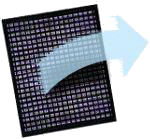Air Quality

One sure path to energy efficiency in houses is eliminating air leaks. If you cut down the amount of air that has to be heated and cooled, you cut your utility bill substantially. But plugging up all those air leaks means less fresh air inside and this has brought on other problems.
One of the first to be identified was elevated concentrations of volatile organic compounds in the air. Commonly called VOC's, these compounds are used in the manufacture of the many synthetic building products used in most new houses today, including carpeting, flooring, paint, cabinetry, countertops, and the structural framework itself. Hundreds of off-gassing VOC's have been identified, but the one that has captured the most attention is formaldehyde. It is a potent eye and nose irritant and causes respiratory effects. It is also classified by the US Government Environmental Protection Agency as a probable human carcinogen.
In response to the concerns raised by health officials and the public over the last fifteen years, manufacturers of some building materials and furnishings have altered their chemical formulations, significantly reducing the amount of VOC's off gassing from their products.
A brand new house will still have a significant amount of VOC's in the air because the rate at which the VOC's off-gas is highest initially. This phenomenon accounts for the "new house smell" that most new house buyers experience. Delaying a move-in and airing out a house by opening all the windows and running all the exhaust fans will benefit the occupants, even if this is done for only two days, advised John Girman, Director of the Center for Analysis and Studies for the Indoor Environmental Division of the US Government Environmental Protection Agency.
Continuing to keep the windows open and ventilating the house for several day to several weeks, if weather permits, can also be beneficial, added Al Hodgson of Lawrence Berkeley National Laboratory in Berkeley, California, who has been studying indoor air quality for the last 18 years.
After the first month or so, the rate at which the VOC's off gas from building materials may fall off, but Hodgson's research indicates that the off-gassing phenomenon will continue at a slow and steady pace for months or even years. Hodgson measured the indoor air quality in eleven new, but unoccupied houses one to two months after their completion. Some were monitored over a period of about nine months. Overall he found that the concentrations of VOC's in the houses were not "alarming," although the concentrations of some compounds were high enough to produce an odor. The levels of formaldehyde were too low to have a smell, but high enough to cause discomfort in some individuals.
Although the level of VOC's in new houses does fall off over time, buyers can reduce it at the outset by their selection of finishes. Hodgson's research has shown while carpets are generally low emitters of VOC's, a reasonable quality, medium-grade, nylon, certified green label carpet may emit less than the basic grade carpet that most builders offer as standard. Installing the carpet with tack strips instead of an adhesive eliminates a potential VOC source altogether. Synthetic fiber carpet padding emits less than the rebonded padding that most production builders provide.
Hodgson's "certified green label carpet" refers to the green and white Carpet and Rug Institute emission test sticker found on carpeting that meets their emission standard. Their testing program was established after sensational stories about "killer carpets" appeared in newspapers and TV news programs in the early nineties. In a New England lab, mice were exposed to carpet samples and subsequently died. Scientists in other labs including the EPA were never able to replicate these results and the reason for the mice's demise remains unclear.
After the Carpet and Rug Institute started its carpet-testing program, it raised the emission standards, which has further reduced carpet emissions. Even so, carpeting can still have an odor that makes people think that they are being exposed to something awful, Hodgson observed.
Vinyl flooring is a stronger emitter than carpet, but it too should not be a cause for concern, Hodgson said.
The oil-based alkyd and water-based latex paints used in most houses are another source of VOC's. The alkyds, which create a harder, more washable surface, are usually used for bathrooms, kitchens, and the trim around doors, windows and baseboards. They produce a terrible smell and emit hundreds of VOC compounds, but these are almost entirely dissipated after about 48 hours, said John Chang, of the EPA labs in Triangle Park, North Carolina. The latex paints have a different smell and emit only four or five VOC compounds, but these continue to off gas for days and weeks after the paint is dry. "Low VOC" latex paints are now available, but some of these emit formaldehyde and buyers should check the paint emission data, he advised.
Hodgson is currently studying the man-made wood products used in residential construction because most of them contain formaldehyde, and formaldehyde concentrations in the indoor air of new houses have been found to be higher than in other building types. Large quantities of these wood products including cabinet materials, doors, door and window trim and baseboards are found in the finished space of new houses. Man-made wood products are also used extensively in their structural framework. Hodgson is looking at the emissions of formaldehyde and VOC's from each product as well as the amount of exposed surface of each product. He is finding that bare surfaces of wood products can have relatively high emissions, but that surfaces with laminate and vinyl finishes generally have low emissions.
In some cases, products that are considered to be low emitters are turning out to be a significant source of VOC's when viewed in the context of the whole house, Hodgson said. For example, formaldehyde and other VOC's given off by the oriented strand board or plywood used for the subfloor in most new houses today are low when calculated on a square foot or a per piece basis. But Hodgson's research is showing that when the total area of the subflooring in a typical house is taken into account, it can be a significant VOC source and that the overlying carpet and carpet padding are not effective barriers.
Other research in indoor air quality in new houses has focused on the problem of underventilation. Until the last 20 years or so, mechanical engineers could reasonably assume that between air leaks and occupants opening the windows, everyone was getting plenty of fresh air. But as houses have become tighter, less outside air is penetrating through air leaks and with air conditioning; no one opens the windows in the summer anymore.
To rectify this situation, the American Society for Heating, Refrigeration, and Air Conditioning Engineers, commonly known as ASHRAE, proposes that mechanical ventilation be required in all new houses, as it is in most commercial and office buildings. The engineers have not dictated how this should be accomplished, and the desired ventilation rate varies with the size of the house and the number of bedrooms. For a 2,400 square-foot house with four bedrooms, for example, the proposed rate would be .35 changes per hour. At this rate, all the air in the house would be replenished every three hours.
Some homebuilders have suggested that ASHRAE's ventilation proposal could add $1,500 to $6,000 to the cost of a new house, but ASHRAE's proposal could be easily and inexpensively done. One continuously running 100 cfm bathroom exhaust fan that is exhausted to the outside would do the job for a 2,400 square foot house and this modification would cost only $75 to $100 more than the exhaust fan and venting that the builder would already be installing in the bathroom, said Max Sherman, also of the Lawrence Berkeley National Laboratory, who has studied indoor air for 20 years. Putting a smaller continuously running fan in each bathroom is a more expensive solution, but it would distribute the fresh air more evenly.
The ASHRAE proposal includes a sound recommendation for the continuously running fan because occupants turn fans off when they're too noisy. The dedicated exhaust fan should have a sound level of one sone or less so that it won't disturb a household at night when the ambient noise level is low.
Relocating the air-handling unit from the garage to some other place in the house would also improve indoor air quality, Sherman said. In some parts of the country such as Florida and California, houses do not have basements and the air handling equipment is often put in the garage. Unfortunately the ducts for the system often leak so that if a car engine is left running for any length of time, homeowners can unwittingly introduce carbon monoxide into their living areas.

 NACHI CPI
#18092023
NACHI CPI
#18092023
 #244451
#244451

